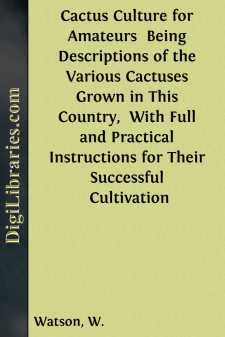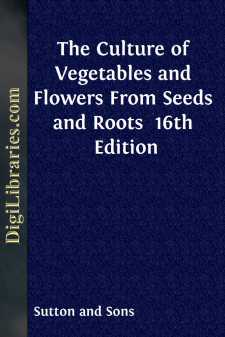Categories
- Antiques & Collectibles 13
- Architecture 36
- Art 48
- Bibles 22
- Biography & Autobiography 813
- Body, Mind & Spirit 141
- Business & Economics 28
- Children's Books 12
- Children's Fiction 9
- Computers 4
- Cooking 94
- Crafts & Hobbies 4
- Drama 346
- Education 46
- Family & Relationships 57
- Fiction 11826
- Games 19
- Gardening 17
- Health & Fitness 34
- History 1377
- House & Home 1
- Humor 147
- Juvenile Fiction 1873
- Juvenile Nonfiction 202
- Language Arts & Disciplines 88
- Law 16
- Literary Collections 686
- Literary Criticism 179
- Mathematics 13
- Medical 41
- Music 40
- Nature 179
- Non-Classifiable 1768
- Performing Arts 7
- Periodicals 1453
- Philosophy 64
- Photography 2
- Poetry 896
- Political Science 203
- Psychology 42
- Reference 154
- Religion 513
- Science 126
- Self-Help 83
- Social Science 81
- Sports & Recreation 34
- Study Aids 3
- Technology & Engineering 59
- Transportation 23
- Travel 463
- True Crime 29
Your Plants Plain and Practical Directions for the Treatment of Tender and Hardy Plants in the House and in the Garden
by: James Sheehan
Description:
Excerpt
CHAPTER I.
HOW TO MAKE A LAWN.
A smooth lawn is a great attraction of itself, even if there is not a tree or shrub upon it. When it is once made, a lawn is easily kept in order, yet we seldom see a good one. There are three things to be taken into consideration in securing a fine lawn. First, location; Second, quality of the soil; Third, the kinds of seed to be sown.
This is the most important matter relating to a good lawn. In selecting a site upon which to build, not the least consideration should be the possibility of having a fine lawn, one that will cost as little as possible to keep in a nice and attractive condition. The nearer level the land is, the better. If a house is built on an elevation back from the road, a sloping lawn has a good effect. Where the land is rolling and hilly, it should be graded into successive terraces, which, though rather expensive, will look well. Low lands should be avoided as much as possible in selecting a site on which it is intended to make a good lawn. Low land can be improved by thorough under-drainage. If the land is wet on which we design making a lawn, we should first thoroughly underdrain it by laying tiles two rods apart, and two feet below the surface. Large-growing trees should never be planted on the lawn, grass will not thrive under them. Fruit trees, like the apple, cherry, and peach, are exceedingly out of place on a fine lawn. The finest yard we ever saw had not a tree on it that exceeded ten feet in hight. Flowering shrubs, low-growing evergreens, a few weeping and deciduous trees of moderate size, with flower-beds neatly planted, make an attractive door-yard.
SOIL.
This is the mother of all vegetation. Nothing, not even grass, will flourish on a poor soil. The quality of the soil varies in different localities. We often find a fine sward on a stiff clay soil, and also on a light gravelly one. The soil best adapted to the growth of a good sward, is a sandy loam with a gravelly bottom. In making new lawns, there is sometimes more or less grading to be done, and often where a knoll has been cut off the sub-soil is exposed, and it will not do to sow the seed upon these patches until the spots have been thoroughly covered with manure which is to be worked in. If a new lawn of any extent is to be made, it should first be plowed deep, and if uneven and hilly, grade it to a level surface. The surface should have a heavy dressing of manure, which should be lightly plowed under, and then the surface should be dragged several times until fine, and then rolled with a heavy roller. The seed may now be sown, after which it should be rolled again. The spring is the best time to do this work, although if the fall be dry, it will answer nearly as well to do it at that time. The dryer the ground in preparing it for the seed, and for the sowing of the same, the better. In preparing a small plot of ground for a lawn, the spade, hand-rake, and small roller may be used in place of the larger implements.
Much difficulty is often experienced in obtaining a good mixture of grass seed for the lawn, and different mixtures are recommended and sold for sowing lawns, some of which are entirely worthless. Great pains should be taken to have nothing but first-class seeds, which should be obtained direct of some responsible dealer. The finest sward we ever saw was made from the following mixture:
10quartsRhode Island Bent-grass.4quartsWhite Clover.8quartsKentucky Blue-grass.6quartsRed-top Grass.Sow at the rate of six bushels to the acre. Grass seed can be sown in the fall any time from the first of October to the first of December. If the seed be sound, a good sward may be expected the following summer, and a good turf may be expected from spring sown seeds if the season is not too dry. The dryer the ground is when the seeds are sown, the better. To keep the lawn in a flourishing condition, fresh and green all summer, it will need a top-dressing of well-rotted manure applied in the fall, at least once every two years. Grass roots derive their nourishment close to the surface, hence the great advantage of top-dressing....






